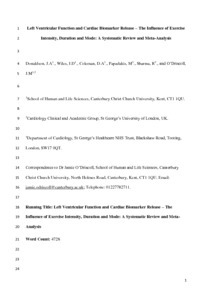Donaldson, JA; Wiles, JD; Coleman, DA; Papadakis, M; Sharma, R; O'Driscoll, JM
(2019)
Left Ventricular Function and Cardiac Biomarker Release-The Influence of Exercise Intensity, Duration and Mode: A Systematic Review and Meta-Analysis.
Sports Med, 49 (8).
pp. 1275-1289.
ISSN 1179-2035
https://doi.org/10.1007/s40279-019-01142-5
SGUL Authors: Papadakis, Michael
![[img]](https://openaccess.sgul.ac.uk/112105/1.hassmallThumbnailVersion/Left%20ventricular%20function%20and%20cardiac%20biomarker%20release.pdf)  Preview |
|
PDF
Accepted Version
Available under License ["licenses_description_publisher" not defined].
Download (615kB)
| Preview
|
Abstract
OBJECTIVE: We performed a systematic review, meta-analysis and meta-regression of exercise studies that sought to determine the relationship between cardiac troponin (cTn) and left ventricular (LV) function. The second objective was to determine how study-level and exercise factors influenced the variation in the body of literature. DATA SOURCES: A systematic search of Pubmed Central, Science Direct, SPORTDISCUS and MEDLINE databases. ELIGIBILITY CRITERIA: Original research articles published between 1997 and 2018 involving > 30 mins of continuous exercise, measuring cardiac troponin event rates and either LV ejection fraction (LVEF) or the ratio of the peak early (E) to peak late (A) filling velocity (E/A ratio). DESIGN: Random-effects meta-analyses and meta-regressions with four a priori determined covariates (age, exercise heart rate [HR], duration, mass). REGISTRATION: The systematic search strategy was registered on the PROSPERO database (CRD42018102176). RESULTS: Pooled cTn event rates were evident in 45.6% of participants (95% confidence interval (CI) 33.6-58.2); however, the overall effect was non-significant (P > 0.05). There were significant (P < 0.05) reductions in E/A ratio of - 0.38 (SMD = - 1.2, 95% CI - 1.4 to - 1.0), and LVEF of - 2.02% (SMD = - 0.38, 95% CI - 0.7 to - 0.1) pre- to post-exercise. Increased exercise HR was a significant predictor of troponin release and E/A ratio. Participant age was negatively associated with cTn release. There was a significant negative association between E/A ratio with increased rates of cTn release (P < 0.05). CONCLUSIONS: High levels of statistical heterogeneity and methodological variability exist in the majority of EICF studies. Our findings show that exercise intensity and age are the most powerful determinants of cTn release. Diastolic function is influenced by exercise HR and cTn release, which implies that exercise bouts at high intensities are enough to elicit cTn release and reduce LV diastolic function. Future EICF studies should (1) utilise specific echocardiographic techniques such as myocardial speckle tracking, (2) ensure participants are euhydrated during post-exercise measurements, and (3) repeat measures in the hours following exercise to assess symptom progression or recovery. It is also recommended to further explore the relationship between aging, training history, and exercise intensity on cTn release and functional changes.
| Item Type: |
Article
|
| Additional Information: |
This is a post-peer-review, pre-copyedit version of an article published in Sports Medicine. The final authenticated version is available online at: http://dx.doi.org/10.1007/s40279-019-01142-5 |
| Keywords: |
Age Factors, Biomarkers, Exercise, Humans, Troponin, Ventricular Function, Left, Humans, Troponin, Exercise, Age Factors, Ventricular Function, Left, Biomarkers, 1106 Human Movement and Sports Sciences, 0913 Mechanical Engineering, 1302 Curriculum and Pedagogy, Sport Sciences |
| Journal or Publication Title: |
Sports Med |
| ISSN: |
1179-2035 |
| Language: |
eng |
| Publisher License: |
Publisher's own licence |
| PubMed ID: |
31214979 |
| Web of Science ID: |
WOS:000476535200009 |
| Dates: |
| Date |
Event |
| 2019-08 |
Published |
| 2019-06-18 |
Published Online |
|
 |
Go to PubMed abstract |
| URI: |
https://openaccess.sgul.ac.uk/id/eprint/112105 |
| Publisher's version: |
https://doi.org/10.1007/s40279-019-01142-5 |
Statistics
Item downloaded times since 30 Jun 2020.
Actions (login required)
 |
Edit Item |



